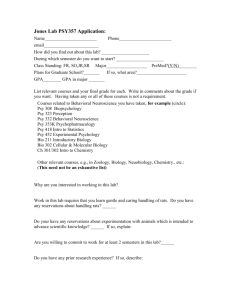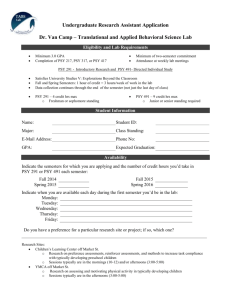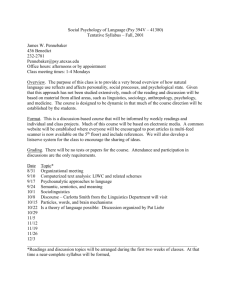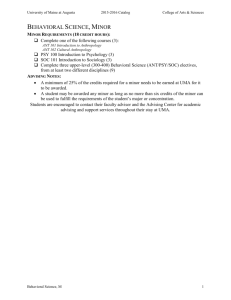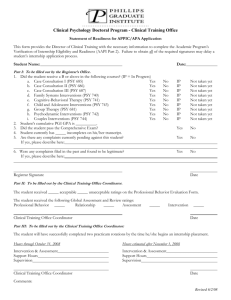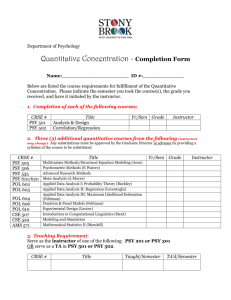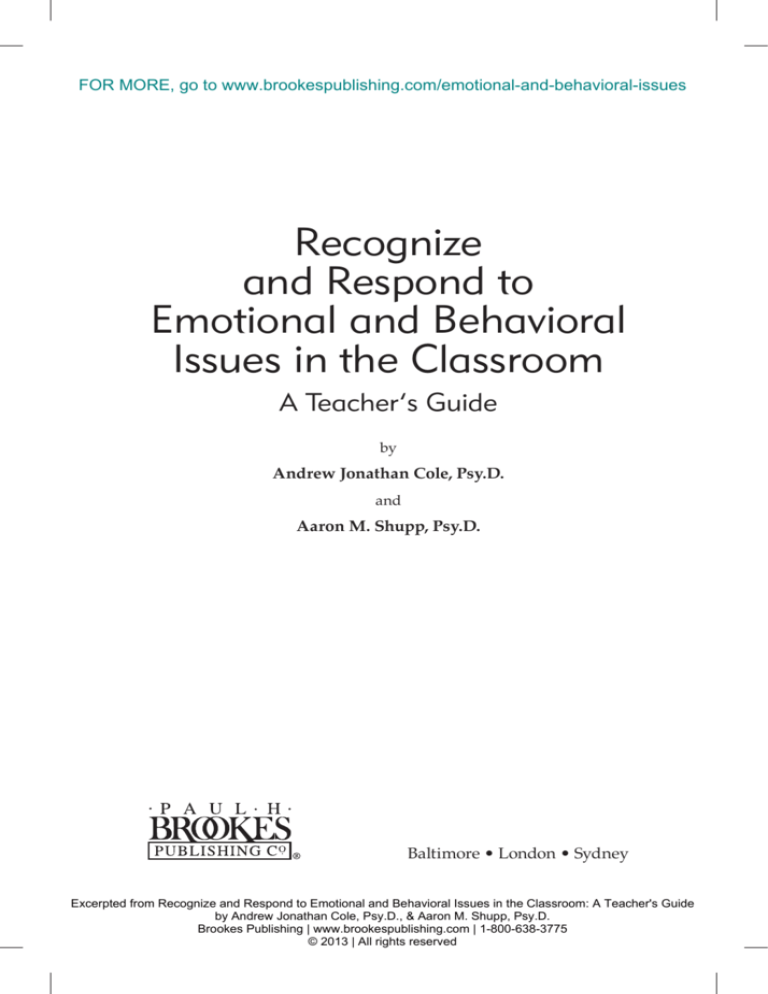
FOR MORE, go to www.brookespublishing.com/emotional-and-behavioral-issues
Recognize
and Respond to
Emotional and Behavioral
Issues in the Classroom
A Teacher’s Guide
by
Andrew Jonathan Cole, Psy.D.
and
Aaron M. Shupp, Psy.D.
Baltimore • London • Sydney
Excerpted from Recognize and Respond to Emotional and Behavioral Issues in the Classroom: A Teacher's Guide
by Andrew Jonathan Cole, Psy.D., & Aaron M. Shupp, Psy.D.
Brookes Publishing | www.brookespublishing.com | 1-800-638-3775
© 2013 | All rights reserved
FOR MORE, go to www.brookespublishing.com/emotional-and-behavioral-issues
Contents
About the Forms and Handouts . . . . . . . . . . . . . . . . . . . . . . . . . . . . . . . . vii
About the Authors . . . . . . . . . . . . . . . . . . . . . . . . . . . . . . . . . . . . . . . . . . . . . ix
Acknowledgments . . . . . . . . . . . . . . . . . . . . . . . . . . . . . . . . . . . . . . . . . . . . . xi
Introduction . . . . . . . . . . . . . . . . . . . . . . . . . . . . . . . . . . . . . . . . . . . . . . . . . xv
1
2
3
4
5
6
7
8
9
10 11 12 Guiding Concepts . . . . . . . . . . . . . . . . . . . . . . . . . . . . . . . . . . . . . . . . . 1
Poor Concentration and Impulsive Behavior . . . . . . . . . . . . . . . . . . 7
Low Moods . . . . . . . . . . . . . . . . . . . . . . . . . . . . . . . . . . . . . . . . . . . . . . 17
Refusing School . . . . . . . . . . . . . . . . . . . . . . . . . . . . . . . . . . . . . . . . . . 29
Performance Stress . . . . . . . . . . . . . . . . . . . . . . . . . . . . . . . . . . . . . . . 41
Problems with Authority Figures . . . . . . . . . . . . . . . . . . . . . . . . . . . 49
Fitting in with Peers . . . . . . . . . . . . . . . . . . . . . . . . . . . . . . . . . . . . . . 59
Aggression . . . . . . . . . . . . . . . . . . . . . . . . . . . . . . . . . . . . . . . . . . . . . . 67
Students Who Are Bullied . . . . . . . . . . . . . . . . . . . . . . . . . . . . . . . . . 77
Personal Boundaries . . . . . . . . . . . . . . . . . . . . . . . . . . . . . . . . . . . . . . 85
Other Social, Emotional, and Communication Problems . . . . . . . 93
Engaging the Family . . . . . . . . . . . . . . . . . . . . . . . . . . . . . . . . . . . . 103
References and Recommended Reading . . . . . . . . . . . . . . . . . . . . . . . . 111
Index . . . . . . . . . . . . . . . . . . . . . . . . . . . . . . . . . . . . . . . . . . . . . . . . . . . . . . 113
v
Excerpted from Recognize and Respond to Emotional and Behavioral Issues in the Classroom: A Teacher's Guide
by Andrew Jonathan Cole, Psy.D., & Aaron M. Shupp, Psy.D.
Brookes Publishing | www.brookespublishing.com | 1-800-638-3775
© 2013 | All rights reserved
FOR MORE, go to www.brookespublishing.com/emotional-and-behavioral-issues
About the Authors
Andrew Jonathan Cole, Psy.D., is a licensed psychologist in New York
and Maine. Currently, he conducts psychoeducational assessments and
provides consultation for primary and secondary schools and mental
health clinics. His diverse experience and training also include work
in a university counseling center, private practice, outpatient and inpatient treatment facilities, and as the supervisor of a forensic rehabilitation program. As an individual and family psychotherapist, he supports struggling students with educational and behavioral problems
and their caregivers.
Dr. Cole holds both a Psy.D. and M.A. in clinical psychology from
Ferkauf Graduate School of Psychology, Yeshiva University; an M.A.
in forensic psychology from John Jay College of Criminal Justice, City
University of New York; and a B.A. in psychology from The Pennsylvania State University. He now lives and works in Maine, where he
enjoys exploring the wilderness and writing essays and poetry in his
spare time.
Aaron M. Shupp, Psy.D., is a licensed psychologist in New York. He has
been providing psychological services to children, families, and adults
for more than 10 years in settings that have included outpatient clinics,
inpatient hospitals, and school-based treatment programs. His practice
has included individual, family, and group psychotherapy; psychological assessments; systemic interventions; and consultation. Dr. Shupp
has worked in both private practice and public service. His work also
includes assessment and treatment of forensic patients, for which he has
been called to provide expert testimony.
Dr. Shupp earned his bachelor’s degree from Whittier College and
graduated in 2004 from Pacific University School of Professional Psychology with his doctorate in clinical psychology.
Dr. Shupp previously worked as the only psychologist in a schoolbased treatment program for children with serious emotional and behavioral challenges. He worked closely with teachers, community providers, families, educational staff, and school administrators to develop
and implement effective, individualized treatment plans for students
ranging in age from 5 to 17.
ix
Excerpted from Recognize and Respond to Emotional and Behavioral Issues in the Classroom: A Teacher's Guide
by Andrew Jonathan Cole, Psy.D., & Aaron M. Shupp, Psy.D.
Brookes Publishing | www.brookespublishing.com | 1-800-638-3775
© 2013 | All rights reserved
FOR MORE, go to www.brookespublishing.com/emotional-and-behavioral-issues
x
About the Authors
Interest in educational issues comes naturally for Dr. Shupp, who
was raised by two educators and is married to a teacher. In addition
to educational issues, he has special interests in ethics, multicultural
issues, public policy, institutional and systemic issues, and forensic psychology. Dr. Shupp lives in upstate New York, where he enjoys spending
time with family and friends, being outdoors, and embarking on new
adventures with his wife.
Excerpted from Recognize and Respond to Emotional and Behavioral Issues in the Classroom: A Teacher's Guide
by Andrew Jonathan Cole, Psy.D., & Aaron M. Shupp, Psy.D.
Brookes Publishing | www.brookespublishing.com | 1-800-638-3775
© 2013 | All rights reserved
FOR MORE, go to www.brookespublishing.com/emotional-and-behavioral-issues
Introduction
The demands of teaching are seemingly endless—planning curricula,
writing and carrying out lesson plans, maintaining knowledge of state
and local standards, taking part in regular training and continuing
education activities, accommodating the individual learning style of
each student, preparing students for standardized testing, holding parent conferences, being available for student and parent questions and
concerns, participating in committees to address everything from individual student learning needs to district-wide issues, and grading and
keeping records (often after work hours), just to name a few! In addition
to these tasks, educators are now often the front line for identifying and
intervening with emotional and behavioral problems, and in many cases
they have a limited supply of time and resources. At the same time, the
psychological principles and knowledge that can be helpful with these
students is not always readily available or easily accessible. This book is
based on our work with students, teachers, and guardians in a variety
of settings and is intended as a resource that provides direct, straightforward recommendations for working with emotional and behavioral
problems in the classroom.
BACKGROUND
To address the realities of a profession in which time is a limited and
valuable commodity and in which student challenges must be regularly
addressed, the recommendations in this guidebook are presented in a
focused, concise format that can be accessed quickly for use in the dayto-day work of educators. The recommendations we provide are based
on sound psychological principles that have been consistently borne out
xv
Excerpted from Recognize and Respond to Emotional and Behavioral Issues in the Classroom: A Teacher's Guide
by Andrew Jonathan Cole, Psy.D., & Aaron M. Shupp, Psy.D.
Brookes Publishing | www.brookespublishing.com | 1-800-638-3775
© 2013 | All rights reserved
FOR MORE, go to www.brookespublishing.com/emotional-and-behavioral-issues
xvi
Cole and Shupp
in research literature. They are also the strategies we have found helpful
in our clinical and consulting experiences.
The recommendations contained in this book are in no way intended as a replacement for structured intervention programs. Formalized intervention programs play an important role in behavior management. Educators who have training in such models are likely to find
them useful and effective. These programs, however, often require formal assessment of student needs, additional training for educators, and
collaboration with other professionals who are trained to oversee the
implementation of these approaches. This guidebook is designed to be a
starting point for everyday challenges.
Although the recommendations are based on well-established psychological principles, they are not unique to any specific research findings. Our approach to creating this guidebook was to compile recommendations we might give if asked to provide consultative input on the
spot; the recommendations are therefore informed by, but not directly
connected to, any specific research. This style of organization permitted
a more fluid, accessible, and readable guidebook for daily use.
WHEN TO USE
We envision certain situations in which this guidebook will be most useful. The most obvious scenario for using this guidebook may be when
your standard behavior management techniques are not working for a
specific situation. However, it will also be helpful to review the recommendations when you are simply questioning whether your approach
is likely to be effective. Sometimes, just finding that you are on the right
track can be comforting and reassuring and may help you to stay the
course through a challenging time. Of course, when you find yourself
faced with a novel or unfamiliar situation, it may be helpful to seek out
recommendations and see how they match up with the approach you
might have instinctively taken.
FORMAT
To allow quick and efficient access to pertinent information, each chapter
follows a consistent format. The title of each chapter reflects a common
problem that might be observed in the classroom. Diagnostic terms and
labels are avoided because the reader is not expected to be in the role of
formally assessing or diagnosing the student. A case study is presented
first for the purpose of illustrating the challenges that might be present.
Specific, observable behaviors are then noted in the section “What You
Excerpted from Recognize and Respond to Emotional and Behavioral Issues in the Classroom: A Teacher's Guide
by Andrew Jonathan Cole, Psy.D., & Aaron M. Shupp, Psy.D.
Brookes Publishing | www.brookespublishing.com | 1-800-638-3775
© 2013 | All rights reserved
FOR MORE, go to www.brookespublishing.com/emotional-and-behavioral-issues
Introduction
xvii
Might See.” “Description of Problems” is where you will find general
information on the problem being addressed, such as possible causes,
associated problems, and how the problem is being defined for the purpose of the chapter. The Recommendations section is divided into three
segments: “Classroom Structure,” “Collaborating with the Student,”
and “Collaborating with the Family/Caregivers.” The section titled “Referral to an Administrator, Counselor, or Mental Health Professional”
provides guidelines for when additional consultation or referral may be
necessary. Finally, “What to Expect” illustrates how the recommendations might be applied to the case study.
After each chapter, you will find additional resources either in the
form of a worksheet you can reproduce and use as needed, an exercise
to clarify where to start for your specific situation, or an informational
handout. In addition, discussion questions are presented at the end of
each chapter to spark your own further exploration of the topic or to be
used in peer reading or study groups.
TIPS FOR USING this book
The first chapter of this guidebook reviews some general principles of
classroom management and behavioral interventions. We encourage you
to become familiar with these concepts because they are the foundation
of many of the recommendations that follow. With an understanding of
the underlying principles, you will be well equipped to creatively adapt
the recommendations to your particular situation. And remember, any
strategy you implement will need to be consistently carried out to be
effective. Unfortunately, this often means enduring periods of time that
bring to mind the old adage, “Sometimes things get worse before they
get better.” Change does not happen quickly, but it does happen!
Collaboration is stressed as a key element of successful interventions throughout this guidebook. Perhaps the most important form of
collaboration, however, will be the collaboration between you and the
recommendations that follow. Whether you are a seasoned teacher or
preparing for your first student teaching experience, you bring a wealth
of personal knowledge and experience. From your first day as a teacher,
you begin acquiring knowledge about what has worked and what has
not worked with similar students, when you have felt successful and
when you have felt ineffective, and, most important, the individual nature of each student. In fact, other than family members, it is often a
teacher who knows a child best. The recommendations in this guidebook
will make the greatest impact when you put them in the context of your
expertise and knowledge and tailor them to your specific situation.
Excerpted from Recognize and Respond to Emotional and Behavioral Issues in the Classroom: A Teacher's Guide
by Andrew Jonathan Cole, Psy.D., & Aaron M. Shupp, Psy.D.
Brookes Publishing | www.brookespublishing.com | 1-800-638-3775
© 2013 | All rights reserved
FOR MORE, go to www.brookespublishing.com/emotional-and-behavioral-issues
xviii
Cole and Shupp
LIMITATIONS
The recommendations contained in this guidebook should not be
considered psychotherapy and, as previously stated, are not part of a
structured intervention program. These strategies are designed to be
implemented without any additional training, and are flexible enough
to tailor to your particular situation. When addressing specific problem
behaviors, however, caution should be taken to work within your area
of competence and training. Avoid assuming the role of counselor or
diagnostician. As a person who is dedicated to helping young people,
you may certainly be willing to help a child through an emotional or
behavioral challenge, and may even feel it is your responsibility to do
so. Similarly, it can be tempting to conclude that a student has a particular disorder or condition, but doing so puts you at risk of causing
harm to the student, alienating the family, and being held personally
liable. Maintain awareness of the limits of your training and expertise,
and be mindful of the situations and circumstances in which you may
feel compelled to reach beyond your qualifications. Many competent,
well-intentioned professionals cause problems for themselves and the
individuals they are trying to help when they lose sight of their role and
find themselves working outside their area of expertise.
This guidebook should not be a substitute for consultation with
colleagues and supervisors or for referral to other professionals. Each
chapter will conclude with guidelines for when to consult an administrator, counselor, or mental health professional. There are, of course,
some instances in which referral or consultation is always warranted.
Anytime you suspect abuse or mistreatment, it will be beneficial to
initiate a referral or consultation, and it is your legal mandate to follow all state and local reporting guidelines. Similarly, your district or
state may require a specific course of action in cases of suspected, reported, or observed bullying, whether in your classroom, outside of the
classroom, or online. Direct suicidal statements; statements or behavior
that reflect hopelessness, despair, or worthlessness; any other reason
for suspecting that a student may harm him- or herself or others; and
reported or observed self-injury or neglect of basic self-care should always be taken seriously and reported immediately. Because this topic
cannot be adequately covered in this guidebook, we strongly encourage
all teachers to seek out training in how to identify signs associated with
risk of suicide, abuse, and violence. Although not as clearly identifiable,
any abrupt changes in a student’s mood, behavior, or academic or social functioning should also warrant prompt referral or consultation. In
short, this book is not intended to replace legal, ethical, or professional
requirements for acting to ensure the safety of all students.
Excerpted from Recognize and Respond to Emotional and Behavioral Issues in the Classroom: A Teacher's Guide
by Andrew Jonathan Cole, Psy.D., & Aaron M. Shupp, Psy.D.
Brookes Publishing | www.brookespublishing.com | 1-800-638-3775
© 2013 | All rights reserved
FOR MORE, go to www.brookespublishing.com/emotional-and-behavioral-issues
Chapter
1
Guiding Concepts
T
here are many high-quality resources on classroom management. This chapter contains information on some of the foundational concepts that underlie many of the recommendations in
the following chapters. However, the reader who is interested in more
comprehensive resources on classroom management is referred to the
­Resources and Recommendations for Further Reading list at the end of
the book.
Few concepts in psychology are so widely accepted that they have
become ubiquitous in the literature. We will present three such concepts
here. These principles form the foundation of many psychological interventions and treatment programs. They can be thought of as necessary
ingredients of a successful intervention, but not the complete recipe!
Whether working with a student or guardian, your effectiveness
will be greatly influenced by three factors: establishing a positive relationship, setting realistic and attainable goals, and using effective reinforcement. Pertinent information and recommendations related to each
of these areas are presented below.
POSITIVE RELATIONSHIPS
• Focus on establishing a relationship built on respect, validation, and
collaboration. Students and caregivers alike will be more open to
working with you when they feel as if their perspectives are understood and valued and when their input is solicited.
• Find at least one quality you really like about each student. When
this seems most difficult, it is most important!
1
Excerpted from Recognize and Respond to Emotional and Behavioral Issues in the Classroom: A Teacher's Guide
by Andrew Jonathan Cole, Psy.D., & Aaron M. Shupp, Psy.D.
Brookes Publishing | www.brookespublishing.com | 1-800-638-3775
© 2013 | All rights reserved
FOR MORE, go to www.brookespublishing.com/emotional-and-behavioral-issues
2
Cole and Shupp
• Find small ways to show each student that he or she is important
to you, such as greeting the student in the morning, remembering
something specific that the student shared, and asking questions.
Even if you do not get an obvious reaction, never underestimate the
impact of simple questions or statements, such as, “John, you said
you were going to go camping this weekend; how did it go?” or, “I
know you’re really good at building things, Tara, so I may need your
help setting up for a special activity later.”
• With students, make an effort to find out about their interests. Notice what they say about themselves and their values through dress
and personal accessories. Most students will quickly reject anything
that looks like faking knowledge or interest in a topic. Rely instead
on the natural desire most students have to share their interests with
others. Look for opportunities to allow the student to teach you
something.
• With parents, acknowledge their expertise and experience, and make
clear your affection for the student and desire for the student to do
well in your class. If parents or guardians think that you do not like
the student or that you are more interested in punishing the student
than in helping him or her, you will quickly lose their support. With
particularly frustrating behavior, this may mean taking time to write
down the student’s positive qualities and your goal for the student
in your classroom, so that these are clear in your mind and you can
communicate them clearly to the guardians.
• Maintain professional boundaries. It may seem easier and faster to
form a relationship as a friend or confidant, but putting in the time
and effort to develop a strong relationship within firm professional
boundaries will foster feelings of security, comfort, and trust among
your students and will teach them about healthy relationships.
• Avoid using labels such as attention-deficit/hyperactivity disorder
(ADHD) or autism spectrum with students or guardians unless they
have volunteered this information or they are comfortable using
such language as contained in the school’s psychoeducational assessment of the child. Focus instead on direct observations and your
willingness to help in connecting them with whatever resources may
be helpful, such as a school counselor.
• Try not to take negative behavior personally. Remind yourself that
the difficulties the student is displaying are the result of many complex factors and that your willingness to help is not the same as assuming responsibility to fix the problem. Lasting change usually involves the efforts of many people and requires the full commitment
of the student and guardians.
Excerpted from Recognize and Respond to Emotional and Behavioral Issues in the Classroom: A Teacher's Guide
by Andrew Jonathan Cole, Psy.D., & Aaron M. Shupp, Psy.D.
Brookes Publishing | www.brookespublishing.com | 1-800-638-3775
© 2013 | All rights reserved
FOR MORE, go to www.brookespublishing.com/emotional-and-behavioral-issues
Guiding Concepts
3
SETTING GOALS
• Know what your ultimate goal is for a student, but identify the small
steps needed to get to that goal. Understand where the student is
now so that you can begin identifying all the small steps that will
be needed to reach the larger goal. It is often helpful to write down
on one side of a paper what you observe of the student now and, on
the other side of the paper, what you would hope to see from this
student. As the student progresses, write down the steps still needed
to move closer to the desired goal.
• Each small step should be attainable. Setting goals that are too far
from the student’s starting point can lead to frustration and discouragement for both you and the student. Setting attainable goals
leads to feelings of success, confidence, and optimism. Each small
goal that is met will create positive momentum toward the next one.
Steps can be as small as a student going from raising his or her hand
once a week to twice a week, or increasing the amount of time spent
focused on an assignment from 3 minutes at a time to 5 minutes at a
time.
• Remember that working toward small goals is not letting the student off the hook or lowering expectations. You know what you
are working toward with the student, and you are actually using a
more effortful and time-consuming approach, but such an approach
is much more likely to be effective. When you feel discouraged, it
sometimes helps to reflect on a difficult goal that you set for yourself and achieved. This achievement likely involved a series of small
milestones (think of your own educational experience!).
• Goals should be clear and observable. It should be easy to determine
whether the goal has been met because it can be observed.
• Goals should be explicit. Let the student know what he or she is
working toward, and, when appropriate, seek the student’s input
in developing goals. The more the student feels like a participant in
the process, the more motivated he or she will be and the more each
success will be internalized or seen as the result of his or her own
efforts.
REINFORCEMENT
• Reinforcement simply means causing a behavior to become more frequent. It can be done by providing something desirable (positive
reinforcement or positive reward) or taking away something undesirable (negative reinforcement or negative reward). Reinforcements
are effective in bringing about lasting change. Punishment refers to
Excerpted from Recognize and Respond to Emotional and Behavioral Issues in the Classroom: A Teacher's Guide
by Andrew Jonathan Cole, Psy.D., & Aaron M. Shupp, Psy.D.
Brookes Publishing | www.brookespublishing.com | 1-800-638-3775
© 2013 | All rights reserved
FOR MORE, go to www.brookespublishing.com/emotional-and-behavioral-issues
4
•
•
•
•
•
•
•
Cole and Shupp
efforts to make a behavior less frequent. Punishment can control
a behavior temporarily, but when used in isolation rarely leads to
positive growth or lasting change. Reinforcements and punishments
are often used in conjunction to simultaneously decrease a negative
behavior while increasing a substitute positive behavior.
Typically, children do not repeatedly engage in behavior that is not
reinforced. Practice looking for what keeps negative behavior going.
What is the benefit for this individual? It is possible, and even likely,
that the person is trying to fulfill a reasonable need.
Reinforcement does not necessarily mean giving a tangible reward.
Sometimes a high five, individual time with a student, or verbal recognition is the most reinforcing thing you can do. These gestures are
often very meaningful, even for students who do not have a noticeable reaction to them.
What is reinforcing for one person may not be reinforcing for another. This seems obvious, but sometimes group rewards are used
for valid reasons, such as constraints on time and resources. When
targeting a negative behavior, however, the reinforcement will need
to be individualized to be most effective.
Just as you set a series of small, attainable goals for a student rather
than one long-term goal, break down reinforcement in a similar
way. Reinforce any behavior that is closer to the next goal than you
have seen before. This is sometimes referred to as shaping behavior.
You are reinforcing each behavior that is a little bit closer to the next
goal rather than waiting until that goal is met.
Remember to focus at least as much time (and preferably more time)
on reinforcing what you want to see as you do on addressing negative behavior. Although negative behavior has to be addressed, it
often comes at the expense of reinforcing positive and expected behavior. Time spent reinforcing expected behavior is an investment
that will help protect you from having to spend more time addressing negative behavior.
Reinforcement does not have to be direct. Other students are always
observing what is being reinforced and what is not. This is another
reason why reinforcing expected behavior is so important. The positive effect extends from the individual student to all the students
who observe the interaction.
Not reinforcing a behavior at all is one of the most effective ways
to make a behavior end. This is called extinction. However, be prepared. When a behavior that has previously been reinforced stops
being reinforced, the behavior temporarily increases. Often, people
Excerpted from Recognize and Respond to Emotional and Behavioral Issues in the Classroom: A Teacher's Guide
by Andrew Jonathan Cole, Psy.D., & Aaron M. Shupp, Psy.D.
Brookes Publishing | www.brookespublishing.com | 1-800-638-3775
© 2013 | All rights reserved
FOR MORE, go to www.brookespublishing.com/emotional-and-behavioral-issues
Guiding Concepts
5
start to doubt themselves during this time and change their strategy
before enough time has gone by for this approach to be effective. If
no reinforcement follows, the behavior will likely end.
OTHER CONSIDERATIONS
• Teaching is a very challenging field. Seek out support from your colleagues and look for opportunities to support other teachers.
• Do not hesitate to consult with others. Even if you think you are on
the right track, sometimes reassurance is helpful to stay the course
through a difficult stretch.
• Take care of yourself. Not only do you teach your subject matter
and address the problems that are the focus of this book, you model
effective skills in many areas, including communication, stress management, and work habits. Making your personal well-being a priority allows you to continue performing this vital work at the highest
level.
Excerpted from Recognize and Respond to Emotional and Behavioral Issues in the Classroom: A Teacher's Guide
by Andrew Jonathan Cole, Psy.D., & Aaron M. Shupp, Psy.D.
Brookes Publishing | www.brookespublishing.com | 1-800-638-3775
© 2013 | All rights reserved

